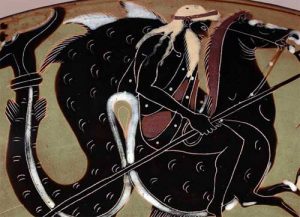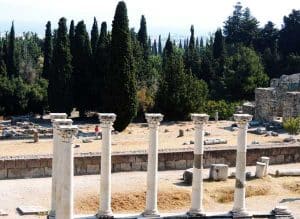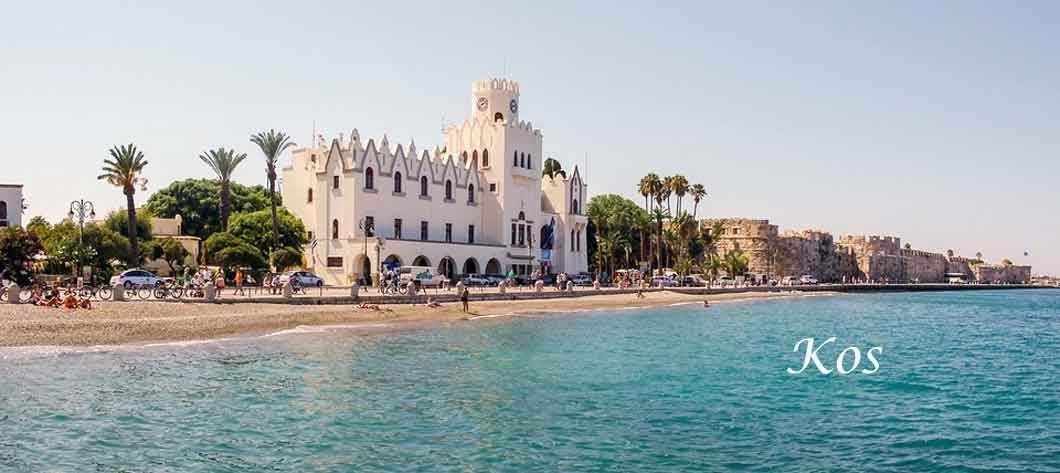History of Kos
The early history of Kos Island extends back to prehistoric times, with evidence suggesting that the island was inhabited by humans as far back as 3000 BC. The earliest traces of human activity on the island can be found in the form of stone tools and pottery fragments, indicating that the inhabitants were engaged in hunting and farming.
During this time, the island was likely inhabited by various tribes who lived off the land and depended on farming for sustenance. However, little is known about these ancient civilizations due to a lack of written records and limited archaeological findings.
It wasn’t until around 1200 BC that Kos came under the influence of Mycenaean Greece. During this period, the island became an important trading center due to its strategic location between Greece and Asia Minor. The Mycenaeans brought with them advanced technology such as bronze metallurgy and their cultural influence can still be seen in some of the artifacts discovered on the island.
As trade flourished on Kos Island, so did its wealth and power. This attracted many invaders throughout its early history, including Egyptians, Persians, and Phoenicians. However, it wasn’t until 700 BC that Greek settlements began to emerge on the island.
The first major Greek settlement was established by Dorians from mainland Greece around 650 BC. They founded a city-state called Astypalaia (now known as Astypalea) which would become one of Kos’ most important cities during ancient times.
In 480 BC, when much of Greece was conquered by Persia under King Xerxes I, Kos joined forces with other city-states such as Athens and Sparta in defeating the Persian army at Thermopylae.
The following century saw Kos flourish both culturally and economically under Athenian rule during a period referred to as “Golden Age” of Athens. This led to a significant increase in architectural achievements such as temples dedicated to gods like Apollo and Athena.
In 366 BC, Kos officially became a part of the Delian League, an alliance formed by Athens to protect Greece from Persian invasions. However, this alliance would eventually lead to their downfall as Sparta and Persia joined forces to defeat Athens in the Peloponnesian War.
Despite these political upheavals, it was during this period that some of Kos’ most famous inhabitants were born, including Hippocrates – known as the “Father of Medicine.”
Kos Island continued to thrive under various rulers such as Macedonian King Philip II and Alexander the Great. It wasn’t until 141 BC that Roman general Quintus Caecilius Metellus conquered the island and made it a part of the Roman Republic.
The early history of Kos Island is rich with cultural exchanges and conquests by various civilizations. From prehistoric times to ancient Greece, its strategic location has played a significant role in shaping its history and leaving behind a legacy that is still evident on the island today.
Mythology
According to Greek mythology, Kos was named after one of Apollo’s sons who was also a healer. It is said that Asclepius was born on this island and learned medicine from his father before becoming the god of healing himself. The most well-known myth involving Asclepius is when Zeus struck him with lightning for bringing people back to life from the dead. This ultimately led to him being immortalized as the constellation Ophiuchus, which can be seen in the night sky.
Another legend states that Kos was where Phoebus Apollo met Daphne, a nymph who he fell deeply in love with. However, just before they could be united, Daphne begged her father, river god Peneus, to turn her into a laurel tree to escape Apollo’s advances. To honor her memory and his unrequited love, Apollo declared Kos as sacred ground and filled it with laurel trees.
The island also has ties to Greek hero Heracles (Hercules), who had many adventures across Greece seeking redemption for his crimes. One such adventure took him to Kos Island where he slayed a giant called Antaeus by lifting him off the ground until he lost strength. To commemorate this momentous event, an ancient temple dedicated to Heracles was built on Kos.
Apart from these prominent figures in Greek mythology, there are many other smaller myths associated with various locations on Kos Island. For example, locals believe that if you drink from the Fountain of Kastri near Zia village at sunset while making a wish, it will come true. Additionally, there is a belief that if you swim through the narrow channel connecting Kefalos Bay to the open sea, you will be granted eternal youth.
The tales and legends surrounding Kos Island add depth and intrigue to its already captivating history. Exploring these myths not only gives visitors a deeper understanding of the island but also allows them to connect with the island’s ancient roots. So on your visit to Kos, don’t miss out on discovering the fascinating mythology that makes this island truly unique.

Kos was also associated with the labors of Hercules, who, according to legend, was shipwrecked along with a few of his companions on the northern beaches of Kos. King Eurypylos, considering Heracles a robber, chased him, causing him to flee to a mountainous place. After his victory over the king of Kos, Heracles left for Phlegra, having previously recognized Chalcona as the rightful king of Kos, Nisyros, Kalymnos and the other neighboring islands. In this way, the generation of Heraklides dominated Kos, from which tradition wants Hippocrates to be descended. Heracles in historical times was worshiped on her island,
Ancient Greek period

In 546 BC the Persian empire subjugates Kos and the administration of the island is taken over by local tyrants on behalf of the Persians. In 478 BC Kos enters the Athenian Alliance and is liberated. In 460 BC, Hippocrates was born.
The successive movements of Kos between the Athenian and Spartan alliances cause civil war as a result of the sharpening of the confrontation between the oligarchic and democratic Kos. The dispute ends with a compromise between the two factions. Part of this compromise was the decision to settle the inhabitants of Kos-Meropides and all the neighboring settlements in a new city, Kos, which remains the capital of the island to this day.
In 288 BC the island falls under the Ptolemaic state. From the beginning, the friendly disposition of the Koos towards the new masters of the island was rewarded by the non-installation of a military garrison on the island, by the exemption from taxation and by the simultaneous preservation of all the privileges of a member state of the Ptolemaic territory. From that year Kos entered the “golden century”, which ends in 197 BC. with the coming of the Romans. The alliance of the Koos and the Romans and the friendly relations with the king of Pergamum, Eumenes II, contribute decisively to the construction of the great temple of Asklepios, but also of all the important monuments of the Roman period of the island.
Byzantine period
During the Byzantine era, the island of Kos witnessed significant transformations that reflected the broader shifts within the Byzantine Empire, from its establishment in the early 4th century until the fall of Constantinople in 1453. This period was marked by both prosperity and adversity, influenced by internal developments and external threats, including pirate raids and invasions.
Initially, with the foundation of the Byzantine Empire under Constantine the Great, Kos, like many Aegean islands, experienced a period of relative stability and growth. The island’s strategic location along important maritime routes ensured its prosperity, facilitated trade, and attracted cultural and intellectual exchanges. During this time, Christianity began to take root on Kos, leading to the establishment of numerous churches and monastic communities, which played a crucial role in the spiritual and social life of the island.
However, the tranquility of Kos was periodically disrupted by external threats. From the 7th century onwards, the Byzantine Empire faced increasing pressure from Arab forces, which led to numerous raids on the Aegean islands, including Kos. These invasions not only caused destruction and loss of life but also disrupted the economic and social fabric of the island, leading to periods of decline.
In response to these challenges, the Byzantine authorities initiated a series of defensive measures, including the construction and reinforcement of fortifications around key settlements and strategic points on Kos. The Castle of Neratzia in the capital and the Antimachia Castle are notable examples of Byzantine military architecture from this period, serving as bastions against invaders and pirates.
The Komnenian and Palaiologan dynasties, during their respective reigns, focused on revitalizing the empire’s provinces, including the Dodecanese islands. Kos benefited from these efforts, seeing a resurgence in agriculture, trade, and the arts. Byzantine art and architecture flourished during this time, with the construction of new churches adorned with frescoes and mosaics reflecting the period’s aesthetic and religious values.
Despite these efforts to maintain and fortify the island, Kos, like much of the Byzantine territory, was not immune to the challenges of the late medieval period. The Fourth Crusade and the subsequent fragmentation of the Byzantine Empire led to a period of uncertainty and shifting control over Kos. In the 13th century, the island came under the rule of the Genoese and later the Knights of Saint John, marking the end of Byzantine sovereignty over Kos.
The Venetian rule and the Knights of Saint John
The Venetian period on the island of Kos, while not as prolonged or direct as in other parts of Greece, still left a notable influence through the broader context of Venetian rule in the Dodecanese and the Aegean Sea. Venice, a powerful maritime republic during the medieval and Renaissance periods, sought control over trade routes in the Mediterranean, including the Dodecanese islands. However, Kos itself was predominantly under the control of the Knights of Saint John during the time when Venice was expanding its influence in the region.
The Knights Hospitaller, also known as the Knights of Saint John, took control of Kos in 1314, after the collapse of the Byzantine Empire’s power in the region due to the Fourth Crusade and the establishment of the Latin Empire. The Knights were crusaders who turned to the Aegean and the Dodecanese islands as a new base of operations against the Ottoman Turks. Under the Knights, the island of Kos became a fortified outpost against Muslim expansion into Europe.
While the Knights of Saint John held Kos, Venice was asserting its dominance over other parts of the Aegean and the eastern Mediterranean. The Venetians were primarily interested in control over trade routes and naval dominance, and their interactions with the Dodecanese were part of this broader strategy. Venetian influence in the region was characterized by the establishment of trade networks, military alliances, and the construction of fortifications to protect Venetian interests.
On Kos, the presence of the Knights Hospitaller meant that direct Venetian rule was limited. However, the architectural and cultural influence of Venetian and Western European styles was evident in the fortifications and buildings erected by the Knights. The Knights adopted and adapted architectural styles and military engineering techniques from their Western European counterparts, including the Venetians, which were reflected in the construction of the Castle of Neratzia at the harbor of Kos Town and the Castle of Antimachia. These fortifications were designed to repel sieges and attacks, primarily from the Ottomans, and were part of a network of defenses that included Venetian-built structures in other parts of the Aegean and eastern Mediterranean.
The Venetian period in the broader Dodecanese context also saw the introduction of new artistic styles, administrative practices, and the flourishing of trade. Goods from Asia, Africa, and Europe passed through the islands, including Kos, contributing to a cosmopolitan atmosphere and the exchange of cultural and intellectual ideas. While Kos was not directly under Venetian rule, the island was undoubtedly influenced by the economic and cultural currents that characterized this period in the eastern Mediterranean.
The Ottoman period
The Ottoman period of Kos, began in 1523 when the island fell to the forces of Suleiman the Magnificent, marking a significant shift in the island’s history that lasted until the early 20th century. This era was characterized by administrative reorganization, changes in the social fabric, and the introduction of new architectural and agricultural practices that left a lasting impact on the island.
With the Ottoman conquest, Kos was integrated into the vast Ottoman Empire, which spanned three continents. The Ottomans implemented their administrative system on the island, dividing the land into timars and hasses, which were granted to Ottoman officials and military personnel as a form of feudal tenure in return for military service. This system led to changes in the agricultural landscape of Kos, with the introduction of new crops and farming techniques that altered the island’s economy and environment.
The social structure of Kos also underwent significant changes during the Ottoman period. The existing Christian Greek population found itself under Muslim rule, leading to a complex coexistence of cultures, religions, and languages. While the Greeks were allowed to practice their religion and maintain certain autonomous institutions, such as the Orthodox Church, they were subjected to the jizya tax and other regulations that distinguished them from their Muslim rulers.
Despite these challenges, the Greek Orthodox community on Kos managed to preserve its cultural and religious identity, maintaining its traditions, language, and customs. The Ottomans also encouraged settlement on the island by bringing in Muslim populations, including Turks and others from different parts of the empire, contributing to the ethnic and cultural diversity of Kos.
Architecturally, the Ottoman period introduced new elements to the island’s landscape. Mosques, baths (hammams), and marketplaces (bazaars) were established, adding to the cosmopolitan character of the island. One of the most notable architectural additions from this period is the Defterdar Mosque in Kos Town, which symbolizes the Ottoman architectural influence. Additionally, the Ottomans reinforced existing fortifications and constructed new ones to protect the island against potential invasions and pirate raids.
The economic life of Kos during the Ottoman period was marked by both continuity and change. Agriculture remained the backbone of the economy, with the cultivation of traditional crops like olives, grapes, and wheat continuing alongside new introductions such as cotton and tobacco. Trade was also significant, with Kos benefiting from its position along maritime routes, though it faced competition from other ports within the Ottoman Empire and from emerging European powers.
Throughout the Ottoman rule, Kos experienced periods of prosperity as well as hardship, including pirate attacks, epidemics, and economic fluctuations. Despite these challenges, the island retained its strategic importance and cultural vibrancy, serving as a meeting point of East and West, where different cultures and religions coexisted and interacted.
The end of the Ottoman era on Kos came in the early 20th century, as part of the larger geopolitical changes in the region following the Balkan Wars and the eventual collapse of the Ottoman Empire.
Modern History
In 1911 Turkey and Italy were involved in a war and from April 1912 the gradual occupation of the Dodecanese by the Italians began. On May 20, 1912, the Italians occupied Kos without a fight and the inhabitants welcomed them as liberators. The Italian government declares that the occupation of the Dodecanese and consequently of Kos will be temporary, and reassures them, saying that the future of the islands can only be autonomy. On July 24, 1923, the Treaty of Lausanne was signed, by which the Dodecanese were annexed to Italy as a possession (Possession of the Italian Islands of the Aegean) and not as a colony. The Dodecanese are considered Italian citizens with idiosyncratic citizenship (Cittadini del Regno instead of Sudditi Italiani) and this mainly means that they neither acquire the rights of Italian citizens nor have the right to elect representatives.
The German Nazis hanged several Kos, both for example and for resistance action. On May 8, 1945, the Germans signed the unconditional surrender to the Allies and the British installed a temporary Military Administration until the final status of the Dodecanese was decided.
On June 27, 1946, the USA, USSR, England and France decided to cede the Dodecanese to Greece. On March 7, 1948, the formal ceremony for the integration of the Dodecanese took place in Rhodes, an anniversary that is celebrated to this day in all the Dodecanese
